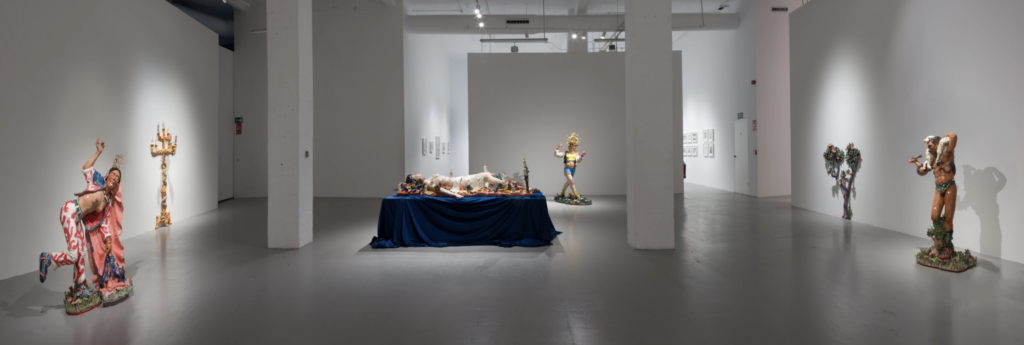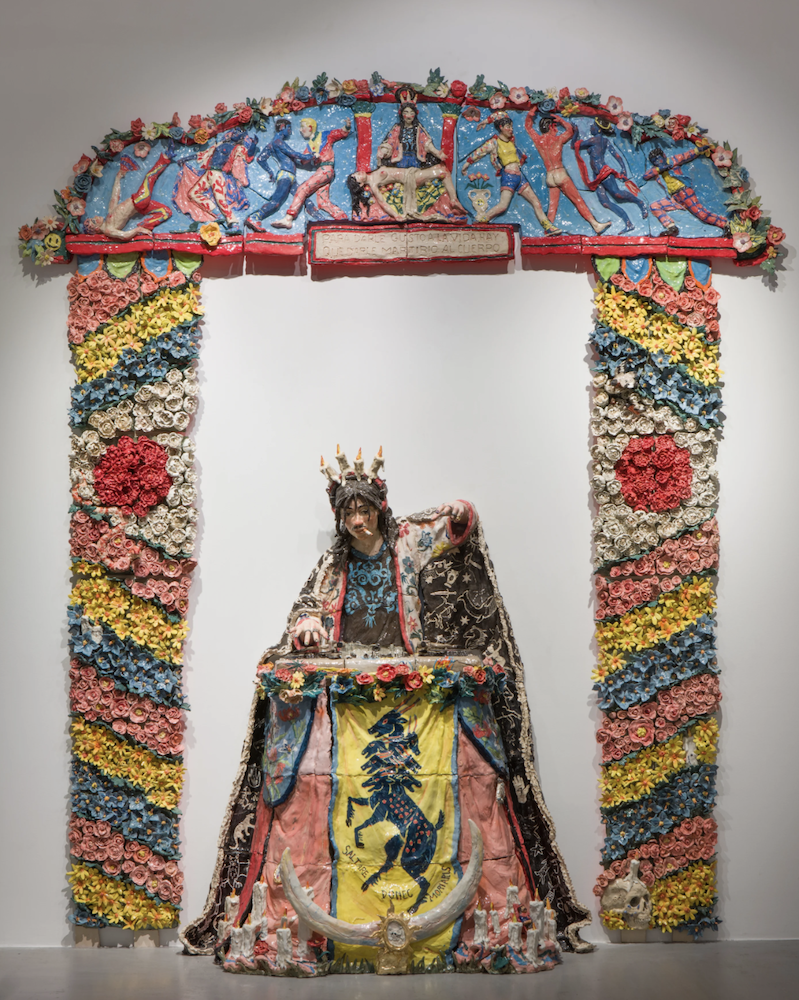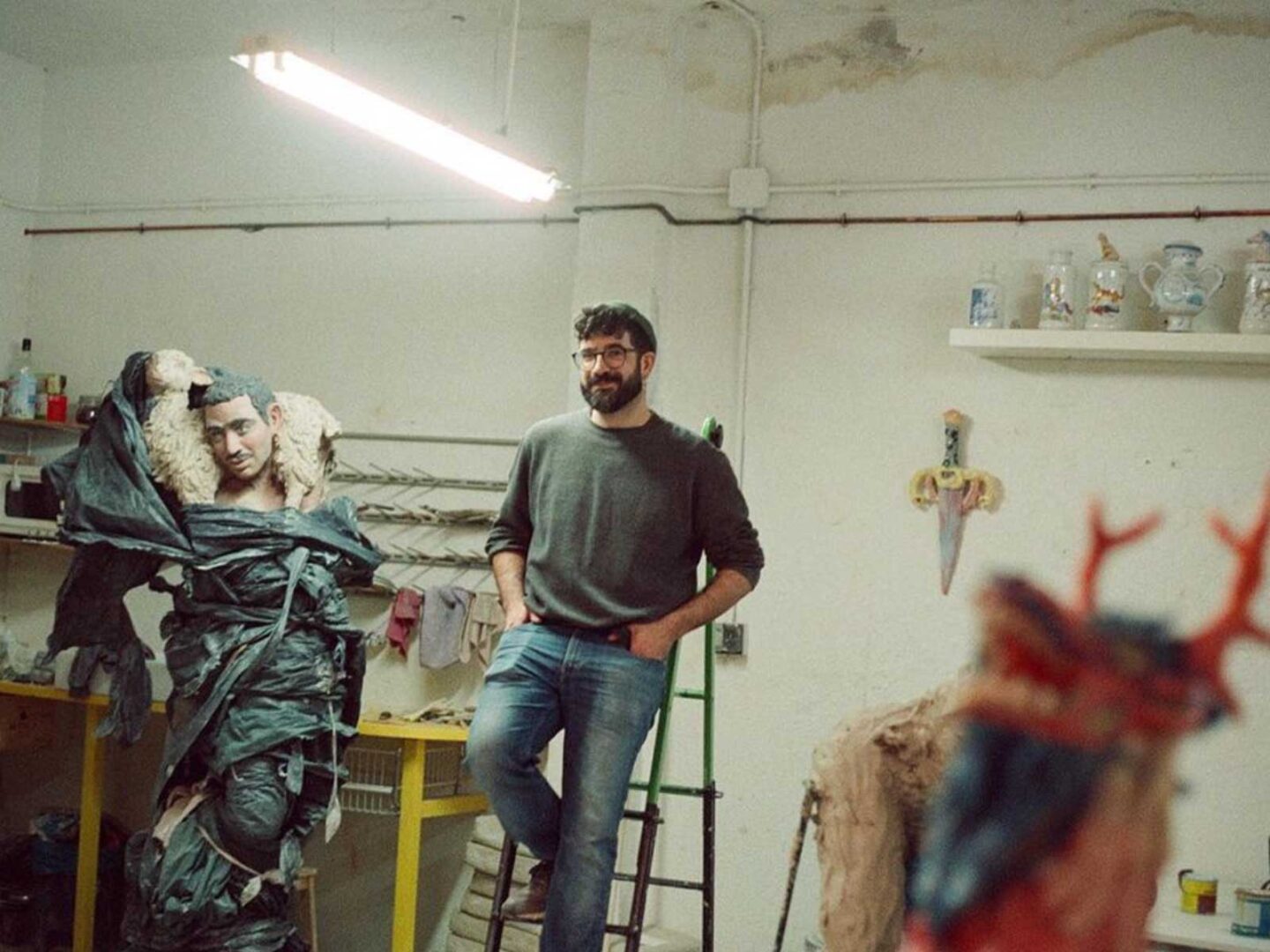Julio Galindo’s work is a platform from which to propose a new mythology that explores terms such as the sacred, the spiritual and the religious. His pieces question concepts such as religiosity or sanctity, trying to update these notions from a contemporary point of view. His intention is to show that there is the possibility of finding profoundly existential aspects in our immediate surroundings, which undoubtedly involves elevating to the level of sacredness things that are not, but probably should be.
Galindo studied Fine Arts at the University of Seville, where he specialised in Painting and Engraving. Since his first contact with ceramics in Florence, his sculptures have been shown in institutions such as the Centro de Arte Tomás y Valiente, Fuenlabrada, Madrid; Centro Cultural La Carolina in Jaén or Palazzo Medici-Riccardi in Florence.
The artist’s current exhibition at VETA begins with a metaphor that compares the state of the planet to the atmosphere of a nightclub in its final hours, when only a few people are left looking to squeeze every last dance out of the night. This farewell scenario is transformed into a representation of humanity on the planet, living on the edge and enjoying pleasures to their ultimate consequences. The artist investigates new religious forms of communion, presenting a scene in which all participants are immersed in excess. This “party of the future” democratises the sacred, bringing spirituality into a festive and profane context.

HIGHXTAR (H) – For those who don’t know you yet, who is Julio Galindo?
JULIO GALINDO (J) – I’m a sculptor born in Extremadura who works with ceramics and who, as a result of having studied painting, has a rather pictorial sculptural work.
(H) – What was your first contact with the art world like?
(J) – The first artistic memory I have in my life is when I went to breakfast one morning and saw that my parents, for no apparent reason, had bought me plasticine tablets and left them in the fruit bowl as a surprise. I went crazy, because I had never tasted those colours and that stuff before. My head exploded. Plasticine became my favourite toy since I was a child, and I think that has influenced my later work quite a lot.
(H) – We met you with your first exhibition at VETA by Fer Francés, now you are back with your latest body of work ‘La Rave de Dios’. How have you evolved professionally and artistically since then?
(J) – I would say that these pieces are more ambitious, more elaborate and have a higher level of technical difficulty. The truth is that ‘La Rave de Dios’ has been a very important step forward in my career. I would dare to tell you that, both technically and professionally, it is the best thing I have ever done.
(H) – ‘La Rave de Dios’ is the title, why this name?
(J) – It was not the first title we had in mind. When we started working on the exhibition, we immediately saw that there was a lot of talk about religious themes. This last feast of humanity that I propose was almost a kind of mass, and I kept thinking of a song by Pony Bravo that is entitled ‘La rave de Dios’ (God’s rave). It’s a group that accompanied me a lot during my university years, so we wanted the title to work as a tribute to them.

(H) – On what basis have you generated this body of work?
(J) – For my previous exhibition at VETA by Fer Francés, ‘Post-apocalypse’, I imagined what the world would be like 10 years after the last human had died. When I explained it to people, I told them it was like the end of a party: the atmosphere is colder, there are fewer and fewer people left, everyone is looking for the next party to go to and clinging on to what’s left in desperation. It’s the same feeling that our relationship with planet Earth gives me: we know that the party is coming to an end, but we cling to our customs in a desperate way.
This gave rise to the idea of representing the last feast of humanity, which also evolved into a reflection on how we want to live our final moments. It was very clear to me that, if it really was the last festival, it was going to be a reflection of a religious or spiritual celebration. It would be more than a normal celebration because we would be giving it extra importance. That’s when I started to reflect on where the spiritualities and rituals of the future will go, how these people will live them.
(H) – What has the creative process been like? Your day to day in the studio.
(J) – It has been the sculptures that have been guiding the creative process. This exhibition has been a very experimental work because we had never made pieces of this size, in such large formats, in the workshop we have. We started by researching from scratch on how to make them, what structures needed these kinds of materials… it’s been a lot of trial and error. And, as I said, each one of the sculptures has been setting the day by day according to its needs. Depending on the drying time, which ones we were clearer about at any given moment, etc., we have been planning days, weeks and even months of work.
(H) – What techniques have you used?
(J) – For ‘La rave de Dios’ I used white earthenware sculpture and engobe decoration. All the solid pieces were built on metal structures that we assembled as a support, which we then needed to dismantle easily. Once the sculptures were dry, emptied and dismantled, we put them in the kiln, glazed them and gave them a final firing.
(H) – Your work questions concepts such as religiosity or sanctity from a contemporary point of view. How do you redefine the sacred today?
(J) – I do not pretend to find a certain answer; rather, I seek to reflect on what is sacred to me and to encourage others to ask the same questions. To democratise those terms. In my particular case, I appropriate religious iconography and discourses to talk about things that affect me on a daily basis, and imbue them with that sanctity and importance. It’s about not limiting these concepts to the religious, but taking them and applying them to our daily lives.
(H) – In this exhibition we see religious figures subjected to a nocturnal world full of excesses. What parallels do you find between these two universes?
(J) – I think my view of religiosity is a bit Bacchic. For me it’s a celebration of life: if there’s anything really important that should be put on an altar, it’s certainly life and how we move through it. From that point of view, there is nothing more spiritual or ritualistic than letting oneself be abandoned to excess and living with nothing else in mind but this kind of bacchanal. In ‘La rave de Dios’ I put a dead person in the centre of the room, and the other characters orbit around him paying homage to his life in the best possible way: by living.

(H) – So general… what would you change about the contemporary art scene?
(J) – We have to change the way we communicate contemporary art to people outside this circle. I see many creators of art content who do it very well, but who don’t know how to reach an audience that is not yet involved in the art world. And on the other hand, there are art creators who do reach a wider public but don’t disseminate quality content. The latter are doing a disservice to the contemporary art world. I think we should pay more attention to how we communicate our work and make an effort to disseminate it beyond the frontiers of the people who already know about this subject.
(H) – Which emerging artist would you recommend to be on our radar?
(J) – There are people that I would recommend, but who maybe are already outside the emerging scene because they are of a different age: Pablo Merchante, Julia Santa Olalla, Francesc Rosselló, Juan de Morenilla, Eloy Arribas, Los Bravú, An Wei, Gema Quiles, Daniel Dobarco, Carlos Pesudo, Javier Ruiz Pérez… Most of them are artists of my generation, and I think we are all creating at the same level and doing very interesting things. Despite the differences, they all form part of that newer or younger national artistic fabric.
(H) – With whom would you like to create a collaborative work?
(J) – Of the people I know, I would like to work with Julio Linares again. We have already done an exhibition together and we have a very similar vision of what we like to create. Also with Cristina Lama. She is another artist who exhibits at VETA by Fer Francés and with whom I would have a lot to see and say. Also, it would be a dream to work with David Hockney, who is my favourite artist, or with Allison Schulnick.
(H) – Apart from this exhibition, which will be open until 30 August… What other projects are you involved in at the moment?
(J) – I’m involved in a couple of commissions that have come up as a result of this exhibition at VETA by Fer Francés. I’m also reading, listening to podcasts, going to exhibitions… In short, trying to see what I’m going to focus on now, because I’d like to get out of this drift of the end of the world. Right now, what I’m doing is researching to see what other narratives I can focus on in the future.

Sigue toda la información de HIGHXTAR desde Facebook, Twitter o Instagram
